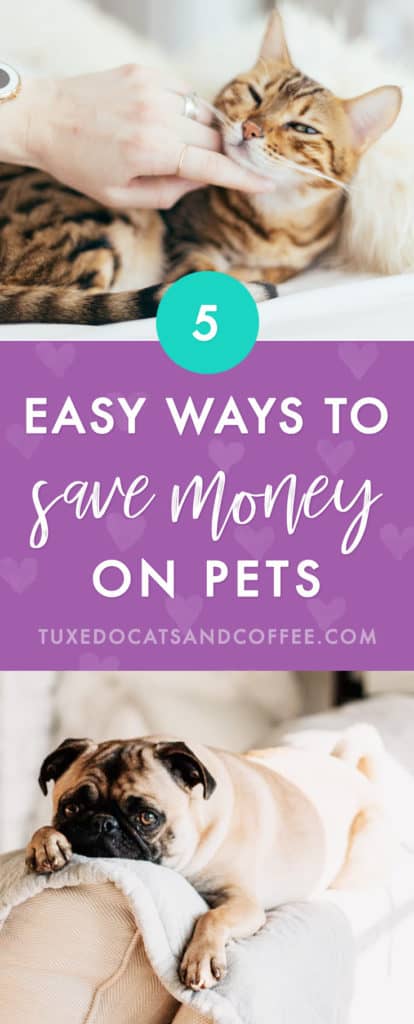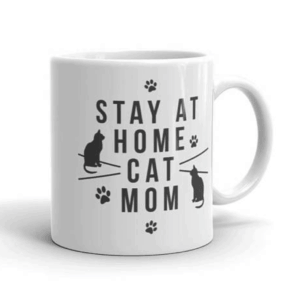Save Money on Pets
Affiliate Disclaimer: This page may contain affiliate links, which means we earn a commission when you buy through our link (at no additional cost to you). As an Amazon Associate, I earn from qualifying purchases. Read our full Disclosure Policy.
Ahh, pets. Our beloved four-legged family members. I always had a cat growing up, and as soon as I was living in my own pet-friendly apartment, I adopted my very own kitten (a tuxedo cat!) to call my own. But pets can be expensive at times, so I planned carefully so adding a new family member wouldn’t cause any money stress. That way, it can be all furry snuggles and no worries. ? Here’s a few tips for how to save money on pets and things that I did to save money while still giving my kitty the best life possible.

This guide is mostly about saving money on cats because that’s what I have. ?
P.S. You can also save money by getting cash back for free on pet supplies you buy through Ebates!
How to Save Money on Pets
- Adopt a cat or kitten with all her vaccinations, and who is already fixed
Those “free kitten” signs outside stores or on Craigslist can be tempting, but most likely these kittens are just born and haven’t had any of their shots or been fixed yet. Those health expenses can actually add up to hundreds of dollars, not to mention the time and stress of taking your poor kitty to the vet multiple times, so it’s best to adopt a cat from a shelter who is already up-to-date on their health. My kitty also already had a microchip inserted in case she ever gets lost. Plus, many shelters will give you a voucher for a free vet exam and coupons for pet supplies.
Pro tip: even if you don’t get a free vet exam voucher from the shelter, most veterinarians will give you a free first exam for your first visit to that vet. Check online to see if they offer it. ? An exam can run anywhere from $50-100, so this could save you a lot.
- Account for all the “hidden” fees with bringing home a new pet.
Adopting a cat comes with a number of expenses, some obvious and some lesser known. The main fee is the adoption fee, which can be around $100 depending on the shelter. A few of the “hidden” fees from adopting my cat: paying for a city pet license, paying for the microchip registration, buying food, litter, a litter box, toys, a scratching post toy, water and food dishes, and a cat carrier. Here are a few cat supplies I recommend that won’t break the bank:
– Cat food
– Litter box
– Cat litter
– Scratching toy
– Toy mice
– Food and water dishes
– Cat carrier
In total, all the supplies above would run you about $100 to get started with your new pet. 🙂
Pro tip: if your cat is still a kitten, leave out your new cat carrier with a nice little blanket or cushion inside and sprinkle catnip all over it. My cat actually started sleeping in her carrier every day and absolutely loves it! Now if we have to travel somewhere in her carrier, she’s really excited because she thinks it’s a bed. ? That’s one way to prevent vet- or travel-related pet anxiety.
- Consider adopting an older cat to waive the adoption fee.
If you adopt a cat that’s several years old, sometimes the shelter will waive all the fees and your kitty will still meet all the health requirements and have a microchip, etc. This is a great way to rescue a pet in need who might not otherwise have a home.
- Instead of pet insurance, save money for your pet in case of emergency.
Unless your pet has some pre-existing health problems, pet insurance probably won’t be worth it. I actually had a free 30 days of pet insurance when I brought home Misty and a few days after bringing her home, I realized she was sick and took her to the vet. She ended up having to get some antibiotics and IV fluids but unfortunately even though I had pet insurance, it had a deductible of something like $75 a month in addition to the normal $20 a month fee, and the charges for her were only around $60. Basically even though I had the insurance from the shelter, her vet fees weren’t enough for the insurance to start covering it. That’s also around $200-300 a year in pet insurance depending on your plan, and that money would be better put into savings in case of a pet emergency.
[See Also: 8 Easy Ways to Save Money and Free Budgeting Printables]
- Get decent-quality food and litter to save on healthcare costs.
While I don’t get the super high end grain-free pet food, I do get a good quality store brand that I know is healthier than the super cheap bargain brands like Meow Mix or Alley Cat. I get Purina ONE cat food and it makes Misty all shiny and pretty. ? She loves the food too! I originally got her their kitten food until she was about a year old, and then we seamlessly transitioned over to their indoor adult blend. It’s a middle-of-the-road price and is one of the better brands available at grocery stores (of course, the high end food at specialty pet stores is probably the healthiest for pets, but the cost can also be very high). If you get the super cheap gigantic bags of cat food, your kitty’s health will probably suffer over time because there are a lot of fillers and chemicals in those ones. Also consider getting a brand of dust-free clay litter like Dr. Elsey’s Ultra Premium Clumping Litter because there’s no dust to cause allergies and it clumps super well and can be used for a long time.
In total, since I live in a pet-friendly apartment that doesn’t charge pet rent, I only pay around $10-20 a month for food and litter for Misty (I don’t have to buy a new bag every month), and those are the only ongoing expenses since I got all the other supplies in the beginning. That’s a pretty low price to pay for a whole bunch of furry love! 🙂


